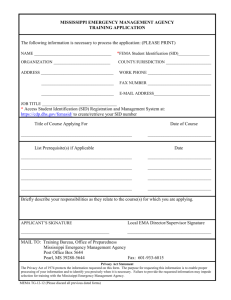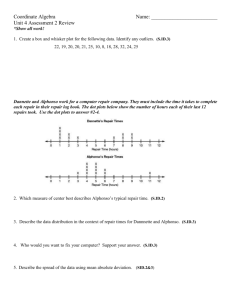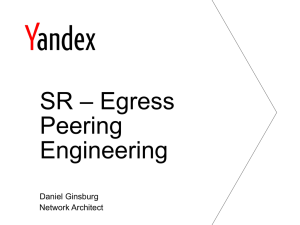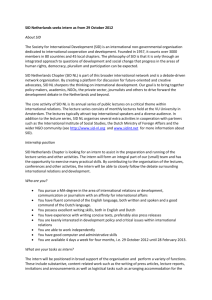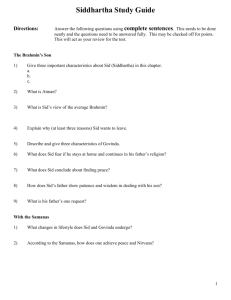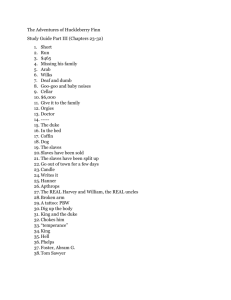Siddhartha Notes, Chapter by Chapter
advertisement
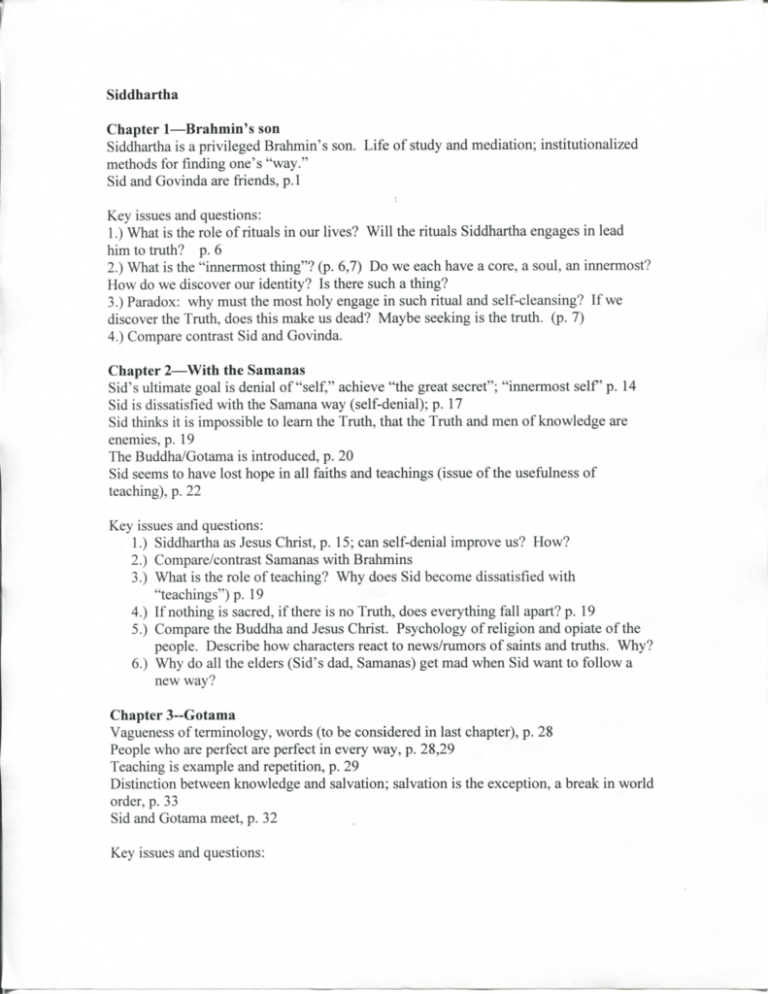
Siddhartha Chapter 1—Brahmin's son Siddhartha is a privileged Brahmin's son. Life of study and mediation; institutionalized methods for finding one's "way." Sid and Govinda are friends, p. 1 Key issues and questions: 1. ) What is the role of rituals in our lives? Will the rituals Siddhartha engages in lead him to truth? p. 6 2. ) What is the "innermost thing"? (p. 6,7) Do we each have a core, a soul, an innermost? How do we discover our identity? Is there such a thing? 3. ) Paradox: why must the most holy engage in such ritual and self-cleansing? If we discover the Truth, does this make us dead? Maybe seeking is the truth, (p. 7) 4. ) Compare contrast Sid and Govinda. Chapter 2—With the Samanas Sid's ultimate goal is denial of "self," achieve "the great secret"; "irmermost s e l f p. 14 Sid is dissatisfied with the Samana way (self-denial); p. 17 Sid thinks it is impossible to learn the Truth, that the Truth and men of knowledge are enemies, p. 19 The Buddha/Gotama is introduced, p. 20 Sid seems to have lost hope in all faiths and teachings (issue of the usefulness of teaching), p. 22 Key issues and questions: 1. ) Siddhartha as Jesus Christ, p. 15; can self-denial improve us? How? 2. ) Compare/contrast Samanas with Brahmins 3. ) What is the role of teaching? Why does Sid become dissatisfied with "teachings") p. 19 4. ) If nothing is sacred, if there is no Truth, does everything fall apart? p. 19 5. ) Compare the Buddha and Jesus Christ. Psychology of religion and opiate of the people. Describe how characters react to news/rumors of saints and truths. Why? 6. ) Why do all the elders (Sid's dad, Samanas) get mad when Sid want to follow a new way? Chapter 3--Gotama Vagueness of terminology, words (to be considered in last chapter), p. 28 People who are perfect are perfect in every way, p. 28,29 Teaching is example and repetition, p. 29 Distinction between knowledge and salvation; salvation is the exception, a break in world order, p. 33 Sid and Gotama meet, p. 32 Key issues and questions: 1. ) What are Sid's values? How are they different? (Independence and creating one's own way) 2. ) Compare/contrast: Sid and Govinda, leader and follower 3. ) Can the Truth be taught? Or can it only be learned through experience? p. 34 4. ) What is Sid's concept of Self and innermost self now? 5. ) Making a distinction between ideas and presentation of ideas, esp. with words. Chapter 4—Awakening Sid identifies a cause and effect relationship to event, linear thinking, p. 37 Sid rejects teachers and teachings, p. 38 Sid re-emphasizes finding the Self, p. 38 Meaning of things versus the thing in itself, p. 40 Key issues and questions: 1. ) What has been accomplished for Sid in Part I? 2. ) The value of making a break from everything you've known (home, family, etc.) to find Self 3. ) What are Sid's plans? What is his approach to living and Truth so far? Part II, Chapter 5—Kamala Sid vows to obey his own irmer-voice, p. 47, 48 Meets ferryman, p. 48, 49 "people are children," p. 49 first sexual desire, p. 50 we meet Kamala, p. 51, 52 Sid asks Kamala for love and she rejects him, p. 54, 55 Sid explains his good fortune with sinking stone metaphor, p. 60 Sid's skills: think, wait, and fast, p. 60 Kamala says Sid is lucky because of his looks, p. 61 Key issues and questions: 1. ) What does Sid mean when he says people are like children? P. 49 2. ) Why does Kamala reject Sid? Because he's not rich? Other reasons? 3. ) Describe Sid's approach to life so far in book 2. Sex, physicality, materialism. 4. ) What does Sid mean when he says anyone can be successful (sinking stone)? P. 60 5. ) Compare/contrast Sid and Kamala. Sid is philosophical and spiritual, Kamala is pragmatic, etc. Chapter 6—Amongst the People What is need and possessions? P. 64 We meet Kamaswami, p. 64 Sid consents to work for Kamaswami only to be with Kamala, p. 66, 69 Sid cares nothing for business, p. 68 Key issues and questions: 1. ) What does Sid learn from Kamala about lover and relationships? Is it just sex? 2. ) Compare and contrast Sid and Kamaswami. Whose way is better? 3. ) Sid works for Kamaswami, but not because he wants to. Is he listening to his inward voice? p. 47, 48, 69 4. ) Is Sid's conduct with Kamaswami's business admirable or selfish? Who is more emlightened? 5. ) How are Kamala and Kamaswami similar? They have their specialties. 6. ) Are Sid and Kamala in love? Can those who are truly independent find love? Is Sid with Kamala for love, or for the experience, and does Kamala see this? Chapter 7—Samsara Sid's original goal has passed, his inspiration is gone, p. 76 Sid feels separate from people and their passions, p. 77 Passion and death are related, p. 81 Sid is sickened at himself and what his life has become, p. 84 Samsara—the game, the dance; between Sid and Kamala and among people, p. 84 Kamala is pregnant with Sid's child, p. 85 Key issues and questions: 1.) Describe Sid's existence now. How did it get this way? Is it understandable? Chapter 8—By the River Sid consider suicide, p. 88, 89 Sid hears "om" and is saved, p. 89 Sid and Govinda reunite, p. 91 Value of experience over knowledge, p. 98 Key issues and questions: 1. ) What is "om"? 2. ) Was Sid's life of materialism a waste? Was it helpful? 3. ) What does Sid mean by "everything is transitory"? p. 94 4. ) Can om/atman be realized only through Sid's way? What about Govinda? Does Govinda understand om? 5. ) What does Sid mean by the death of his Self as a good thing? p. 99 Selfconsciousness; pride, vanity 6. ) Discuss idea of several lifetimes within one; many Selves; everything is transitory, p. 99, 100 Chapter 9—The Ferryman Meet Vasudera (the ferryman) again, Sid offers to become his apprentice, p. 103 Vasudura says Sid will "learn the other thing", p. 105 Sid learns: 1—no such thing as time, 2—river has many voice, p. 106-108 News of Gotama's illness, p. 109 . Why Gotama is a true God/Teacher, p. 110 Kamala and her son arrive (Kamala is a follower of Gotama), p. 110-111 Kamala bit by a snake, later dies, p. 111 Key issues and questions: 1. ) How is the river symbolic? Discuss the meaning of the river to Sid, how is symboHzes his thoughts on life. P. 101, 106-108 2. ) Does Sid grieve at Kamala's death? Why or why not? 3. ) Describe how Kamala has changed. Chapter 10—The Son Sid and Vasudera discuss how best to raise a child, p. 119-120 Nature of loving a child; love versus selfishness, p. 121 Sid first experiences love for another person, as a father: love as new experience/phase, p. 122 Sid's son steals and runs away, p. 124 Sid loses his son, feels sadness and emptiness (failure?), p. 126, 127 Issues and questions: 1. ) What is the best way to raise Sid's son? Describe the irony of Sid trying to "teach" his son? P. 119, 119-120 2. ) Nature of loving a child. When is it love and when is it selfishness? p. 121 3. ) How is Sid's experience with "love" for his son different from his experience of "love" with Kamala? Are both love? 4. ) Is this Sid's first experience with love? How is this a new experience/phase, comparable to others in Sid's life? P. 122 5. ) Nature vs. Nurture. Why is the boy the way he is? 6. ) Why is Sid so helpless with his son? Why hasn't his self-improvement helped him with love and raising a child? p. 124, 126, 127 7. ) Compare Sid as a father with his own father. 8. ) Describe Sid's life as a series of identifies (brahmin's son, samana, lover, businessman, father) and challenges. Chapter 11—Om Sid had new opinion on people in general, p. 129,130 Some universal desires and emotions, p. 130 Sid re-states his goal, meaning of life, p. 131 Sid realizes he relies on Vasudeva, even worships him, and does not like this fact, p. 133 Sid achieves enlightenment/om/understands unity of all things, p. 134-137 Vasudeva leaves (to die; for Nirvana?), p. 137 Issues and questions: 1. ) Are some people more "aware" of unity/om etc. than others? Is there a higher consciousness and is it important? P. 130 2. ) Compare/contrast Vasudiva and Gotama/Buddha. p. 142 3. ) Examine the passages on pages 135-137. Describe Sid's enlightenment in your own words. What has Sid achieved and how does it affect his living? 4. ) Consider the nature of love as a special case. Why does it cause people to act so blindly and irrationally? Think also of John Cole Grady. 5. ) What is the role of laughter in this novel? 6. ) Describe the role of the listener. What makes a good listener? p. 133 7. ) Compare Sid with his father, especially in regard to their children. How does the cycle of repetition, emotion and behavior continue? p. 131, 132 Chapter 12—Govinda Shift in point of view to Govinda, p. 139 Govinda goes to seek ferryman, rumored as a wise man (people will follow, seek at the slightest hint of Truth), p. 139 Idea of seeking too much, missing the point, p. 140 Sid has taken Vasudeva's place, p. 141 Inability of words to express ideas like Om, p. 145 Sid's ideals have reversed: attaches importance to things now, not thoughts, p. 146 Issues and questions: 1. ) Describe Govinda's life (versus Sid's). What is his "way"? p. 139 2. ) Sid always recognizes Govinda when they meet, but Govinda never recognizes Sid. Why? 3. ) What is Sid's understanding of Om/Atman at beginning of the novel, and then at the end? 4. ) What does the line "wisdom is not communicable" mean? p. 142 5. ) What does the line "in every truth the opposite is equally true" mean? p. 143 6. ) Dialectic/opposites—one cannot reason but against something, p. 143 7. ) What is the "potential for Buddha" in all of us? p. 144 8. ) Sid says "love" is the most important thing. What does he mean by this? What does he mean by "love"? p. 147 9. ) Deeds versus opinions and talk, p. 148 (Sartre: we are what we do). 10. ) What is Govinda's conflict at the end? Govinda seeks, but never Joe5 anything, p. 148 11. ) What is Govinda's final image of Sid? Like the river, p. 150 The last two chapters present Sid's final philosophy. By the end, the following are similar and seem to have reached enlightenment: Sid, Gotama, Vasudeva. Questions/ideas for entire novel: (see all questions/ideas for final two chapters) 1. Describe the tone and writing style. (Biblical.) How is it suited to the subject matter and its telling? Mythical quality as well. Much hyperbole; vague descriptions, etc. 2. How does this book present different paths to enlightenment? How was Sid's path unusual, and do you think he took a good or proper path? 3. Compare/contrast various characters. 4. Discuss the "river" in this novel, as a symbolic device and later as a model for enlightenment. Vs. The novel may seem a religious one, but what do you think Sid's attitude toward religion is by the end of the book? What message does the author seem to give concerning organized religion? ^ 6. Put Sid's enlightermient into working terms. Specifically, how can we live the enlightened life that he describes at the end of the novel? Is this idea of enlightenment realistic or practical? Think about your own life; how would you go about changing it in order to live the enlightened life that Sid describes? Vocabulary and issues to discuss before reading the novel: Brahmin, p. 1,2; Om, p . l ; Atman, p. 1; Brahma; Samanas, p. 9; ascetic, p. 9; Indian mythology—^Nirvana, Cycle of existence (re-incarnation), p. 16-18; Buddha, Vishnu, Bahagavida, Yin-Yang; the Eightfold Path] p. 29; class structure and socio-economic conditions in India ^ Related resources/activities: Meditation tapes: spend a portion of the period meditating and describe link with the book; "mantra" Phil Jackson: Hoop Dreams Indian mythology: Nirvana, Cycle of Life, Vishnu Buddhism Movies: Siddhartha movie?; Seven Days to Tibet; Kundun; the Last Buddha (Keanu Reaves) Video on Indian myth/Buddhism? Have students journal their rehgion/philosoph^ Group activity: compare(Gotama, Sid. Vasudivai Govinda. Kamala as enlightened beings; list qualifies on the board.

